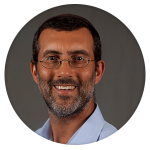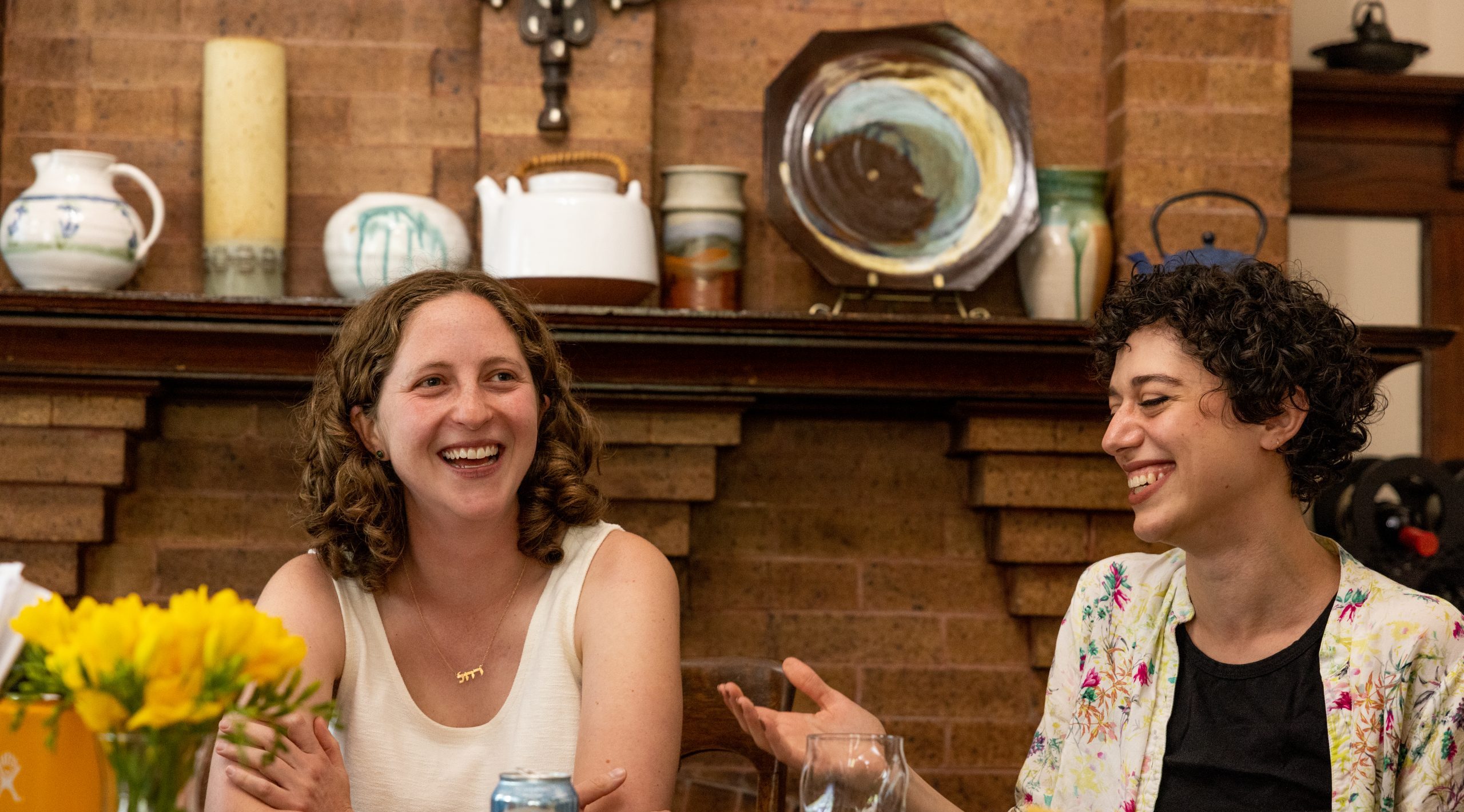May 2019 Newsletter
 Hey Big Talkers: Shhh
Hey Big Talkers: Shhh
Rabbi Lisa Goldstein
We Jews are known for being big talkers. We are stereotypically a people of a lot of words, of arguments, of big ideas, of strong opinions. I remember once speaking to a Catholic boys’ school in Missouri. The first kid raised his hand and said, to his teacher’s mortification, “Our science teacher is Jewish and she talks fast, too. Do all Jews talk fast?” (I quickly said, “Yes!”) It’s not surprising that people frequently raise their eyebrows when they hear what IJS does and ask, “How do you get Jews to be quiet?”
We are coming up to the end of our “kayak trip through the Omer,” as our colleague Marc Margolius has been guiding us, weaving our way through the middot, or ethical traits, that prepare us for the splendor and awe of revelation at Mt. Sinai on Shavuot. On Shavuot, we are told, we get to re-experience the moment of great mythic meeting between the Divine and ourselves, a direct experience of communication with the Source of Life itself, lovingly distilled into Torah, the wisdom for a good life that has been handed down – and yes, discussed and argued over – for generations.
There are all kinds of midrashim about what actually happened at Mt. Sinai. What is striking is how many of them veer away from the Biblical narrative that describes a noisy, thundering encounter and suggest instead that the surprising thing about Sinai was how quiet it was. In fact, it was so quiet that people for once could hear that kol dmama daka, that subtle quiet Voice that is speaking all the time.
I have been reflecting recently on all the unexpected places we might hear that same voice if only we would stop talking and listen instead. I have participated in a number of diversity trainings over the past few months and am appreciating the transformational power of really listening to unique voices of queer Jews and Jews of Color. Through my family I am connecting more with people from other countries and other religions and the more I listen, the more I sense how the life force that flows through them all takes on different garments in sometimes difficult but always marvelous diversity. (That is like Torah itself – sometimes difficult and always marvelous, because Torah too is a garment for Divinity. )
Our teacher Sheila Pelz Weinberg sometimes says that the word “wait” can be considered an acronym for Why Am I Talking? As we are dedicating ourselves to better communication – with each other and with God – perhaps a good first step is simply to listen.
 Conversations with God: Rabbi Nachman’s Hitbodedut
Conversations with God: Rabbi Nachman’s Hitbodedut
Rabbi David Jaffe
Hitbodedut literally means seclusion and in rabbinic literature refers to meditation. However, it is most associated with Rebbe Nachman of Breslov’s practice of speaking freely to God in one’s own native language.
As a pre-teen I used to go out to the woods on my own and talk to God about all the different challenges, primarily social, that adolescence brought my way. Only years later did I learn that I was engaging in a Hasidic prayer practice called Hitbodedut! Rebbe Nachman (1772-1810, Ukraine), urged his followers to make it a daily practice to set aside a certain amount of time every day to talk openly with God about everything and anything. Here he describes the practice in his own words:
Hitbodedut is the highest path of all. One must therefore set aside an hour or more each day to talk with God by herself in a room or in a field.
Hitbodedut consists of conversation with God. One can pour out his words before his Creator. This can include complaints, excuses, or words seeking grace, acceptance and reconciliation. He must beg and plead that God bring him close and allow him to serve God in truth.
One’s conversation with God should be in the everyday language that she normally uses. Hebrew may be the preferred language for prayer, but it is difficult for a person to express herself in Hebrew. Furthermore, if one is not accustomed to speaking Hebrew, her heart is not drawn after the words.
However, in the language that a person normally speaks, it is very easy for him to express himself. The heart is closer to such a language, and follows it, since the person is more accustomed to it. Therefore, when one uses his native language, he can express everything that is in his heart and tell it to God.
(Lekutei Moharan Tinyana 25, adapted from Rabbi Aryeh Kaplan’s translation in Outpouring of the Soul, Breslov Research Institute, 1980, pgs. 20-21)
From this excerpt we can see that there are a few key guidelines for Hitbodedut practice. Set a regular time and place for the practice. I’ve found that it is extremely helpful to build a habit by doing Hitbodedut at roughly the same time every day. For me that is at night before going to bed. For you it could be first thing in the morning, or really any time at all. While the amount of time can vary, consistency is important. In our practice we will give it 20 minutes. Rebbe Nachman recommends one hour, but I’ve found that shorter amounts of time are also powerful. Choose a place where you will not be interrupted. For Rebbe Nachman, doing Hitbodedut out in nature was the ideal. However, any private space will do, including a room where you can close the door.
Once you have your time set aside and your space you are ready to go. I like to start my Hitbodedut by ritually washing my hands and thanking God for this opportunity to talk. You can talk about anything you want. This can include describing your hopes and desires or asking for help with big issues or mundane tasks of daily life. You can focus on your relationship with God, your relationship with other people, your work, or your efforts at self-improvement. You can talk about the state of the world. Really, nothing is too big or too small for Hitbodedut.
It may feel awkward to speak out loud when no one is there and no one answers back. That is okay. I’ve found that it is through the talking process I can come to great clarity and, at times, profound inspiration. Maybe that is God’s response. The key is to keep talking out loud and not drift off into thinking silently in your head. There is something about the talking process that clarifies and imprints on the soul. Sometimes I will get bored during a Hitbodedut session and check my watch to see how much time is left. That is also okay. Just like in meditation where we come back to the breath when distracted, in Hitbodedut, we come back to the conversation. The goal is to speak with God like one speaks with a good friend. Rebbe Nachman encouraged this practice daily as a way of building a close relationship with God. Speaking openly and honestly with God everyday builds this closeness.
Hitbodedut even works for people who don’t believe in God or who are unsure if God exists. I’ve taught this practice over the past decade with dedicated agnostics and atheists, who talk with “higher power” or “ideal support.” Experiment and see what works for you. As Rebbe Nachman writes above, even if you are completely removed from any relationship with God, you can ask for help.
When time is up I like to have a ritual for closing the conversation. I will thank God again for listening. Since I most often do my Hitbodedut outside I will take a moment to look at the dark, nighttime sky and appreciate the beauty. If particularly useful insights came out of the session I will take a few minutes to write them in my journal after finishing the Hitbodedut.
I like to think of Hitbodedut like having special time with my partner, so it is analogous to “date night.” Date night is a time when we go out and just focus on each other. It is time for my partner and me to connect. Traditional Judaism prescribes a set liturgical prayer three times each day. These prayers are like the business of a relationship. Hitbodedut is special time with God.
Instructions for practice:
1. Set a time and place for your Hitbodedut sessions.
2. Make sure you will not be interrupted for the 20-minute session.
3. Create an opening ritual and intention. This can include ritually washing hands, a few minutes of quiet meditation, singing a niggun (wordless tune), or anything else, and thanking God for the opportunity to connect.
4. Speak for 20 minutes about anything on your mind.
5. If you find yourself drifting into quiet thought, return to speaking out loud.
6. At the end of the session engage in a closing ritual. One tradition is to say, “May the words of my mouth and the expressions of my heart be acceptable to you, Holy One, my Rock and Redeemer.” (Psalm 19)
7. If you like (optional) write down any insights in a practice journal.

Dialogues with Ourselves: A Meditation Practice
Rabbi Jonathan Slater
It may seem paradoxical to speak of “dialogues” when addressing meditation, such an inward and solitary practice. But, there are many such “conversations” that are possible in meditation. Of course, there is the rush of thoughts and feelings that become more present to us when we sit quietly. But, beyond that are also these two practices.
One is the query of the observing mind, the mind of awareness, to any complaint or comment of the self: “Is that so?” or “Who says?” or “How do you know that to be true?” or “Who is knowing that?”
The other is the blessing or lovingkindness practice. Recognizing our deepest desires and truest intentions, we incline the heart toward love. We recite these phrases to open the heart to ourselves and all others: “May you feel safe; May you feel happy; May your body be strong; May your life unfold with ease.”
These dialogues deepen our practice, rather than serve as distraction. In this practice, listen to the teaching first, and then, when you’re ready, settle in for the 10-minute guided meditation.
 Mindful Tochacha: Bringing Mindfulness Practice to Difficult Conversations
Mindful Tochacha: Bringing Mindfulness Practice to Difficult Conversations
Rabbi Amy Eilberg
In a society painfully pervaded by coarse and destructive conversation, the need for our skills in mindful speech and listening has never been greater. This webinar explores how to bring our mindfulness practice to difficult conversations at home, at work, and in our work in the world, studying texts on the art of tochacha and contemplating to make moments of difficult conversation part of our practice of mindfulness, compassion, and wisdom.
Click here to download the teaching sheet from this webinar.
 Reaching Out in Love
Reaching Out in Love
Rabbi Sam Feinsmith

